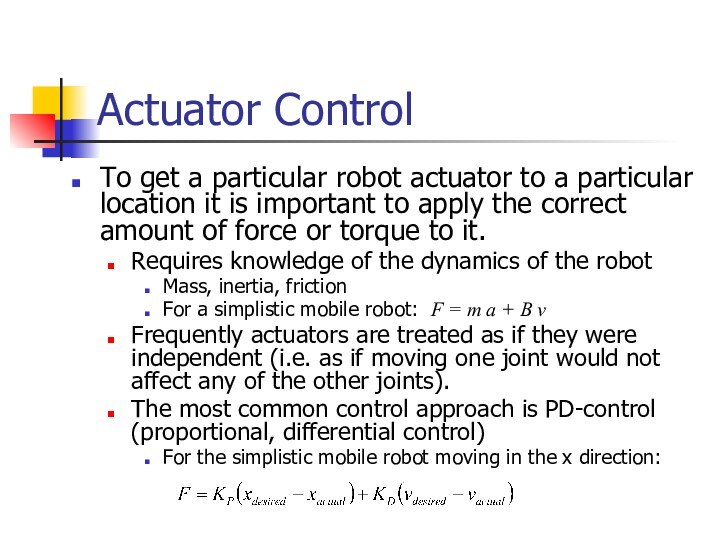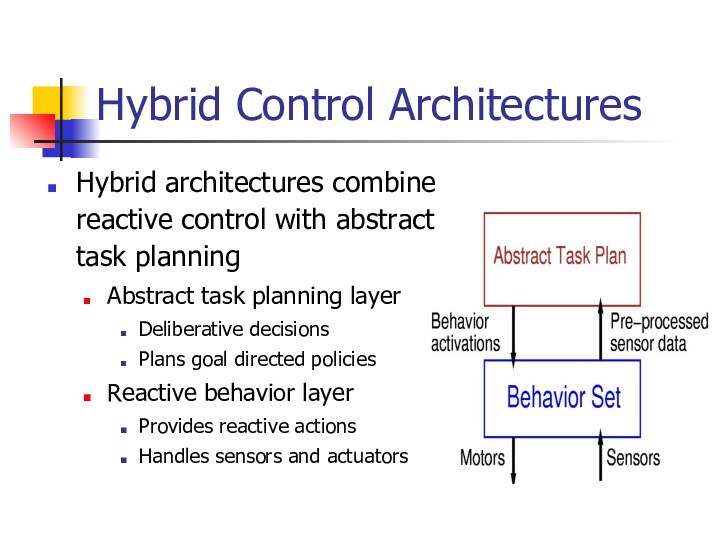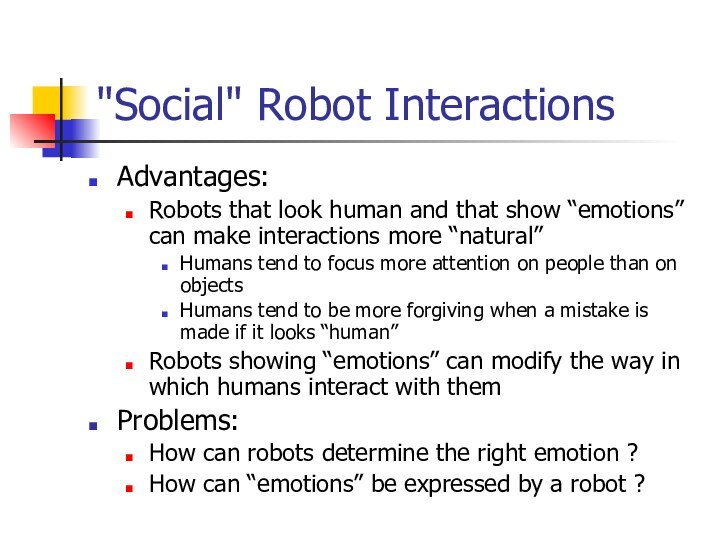Слайд 2
Motivation
Intelligent Environments are aimed at improving the inhabitants’
experience and task performance
Automate functions in the home
Provide services
to the inhabitants
Decisions coming from the decision maker(s) in the environment have to be executed.
Decisions require actions to be performed on devices
Decisions are frequently not elementary device interactions but rather relatively complex commands
Decisions define set points or results that have to be achieved
Decisions can require entire tasks to be performed
Слайд 3
Automation and Robotics in Intelligent Environments
Control of the
physical environment
Automated blinds
Thermostats and heating ducts
Automatic doors
Automatic room partitioning
Personal
service robots
House cleaning
Lawn mowing
Assistance to the elderly and handicapped
Office assistants
Security services
Слайд 4
Robots
Robota (Czech) = A worker of forced labor
From
Czech playwright Karel Capek's 1921 play “R.U.R” (“Rossum's Universal
Robots”)
Japanese Industrial Robot Association (JIRA) :
“A device with degrees of freedom that can be controlled.”
Class 1 : Manual handling device
Class 2 : Fixed sequence robot
Class 3 : Variable sequence robot
Class 4 : Playback robot
Class 5 : Numerical control robot
Class 6 : Intelligent robot
Слайд 5
A Brief History of Robotics
Mechanical Automata
Ancient Greece
& Egypt
Water powered for ceremonies
14th – 19th century Europe
Clockwork
driven for entertainment
Motor driven Robots
1928: First motor driven automata
1961: Unimate
First industrial robot
1967: Shakey
Autonomous mobile research robot
1969: Stanford Arm
Dextrous, electric motor driven robot arm
Maillardet’s Automaton
Unimate
Слайд 6
Robots
Robot Manipulators
Mobile Robots
Слайд 7
Robots
Walking Robots
Humanoid Robots
Слайд 8
Autonomous Robots
The control of autonomous robots involves a
number of subtasks
Understanding and modeling of the mechanism
Kinematics, Dynamics,
and Odometry
Reliable control of the actuators
Closed-loop control
Generation of task-specific motions
Path planning
Integration of sensors
Selection and interfacing of various types of sensors
Coping with noise and uncertainty
Filtering of sensor noise and actuator uncertainty
Creation of flexible control policies
Control has to deal with new situations
Слайд 9
Traditional Industrial Robots
Traditional industrial robot control uses robot
arms and largely pre-computed motions
Programming using “teach box”
Repetitive tasks
High
speed
Few sensing operations
High precision movements
Pre-planned trajectories and
task policies
No interaction with humans
Слайд 10
Problems
Traditional programming techniques for industrial robots lack
key capabilities necessary in intelligent environments
Only limited on-line sensing
No
incorporation of uncertainty
No interaction with humans
Reliance on perfect task information
Complete re-programming for new tasks
Слайд 11
Requirements for Robots in Intelligent Environments
Autonomy
Robots have to
be capable of achieving task objectives without human input
Robots
have to be able to make and execute their own decisions based on sensor information
Intuitive Human-Robot Interfaces
Use of robots in smart homes can not require extensive user training
Commands to robots should be natural for inhabitants
Adaptation
Robots have to be able to adjust to changes in the environment
Слайд 12
Robots for Intelligent Environments
Service Robots
Security guard
Delivery
Cleaning
Mowing
Assistance Robots
Mobility
Services for
elderly and
People with disabilities
Слайд 13
Autonomous Robot Control
To control robots to perform tasks
autonomously a number of tasks have to be addressed:
Modeling
of robot mechanisms
Kinematics, Dynamics
Robot sensor selection
Active and passive proximity sensors
Low-level control of actuators
Closed-loop control
Control architectures
Traditional planning architectures
Behavior-based control architectures
Hybrid architectures
Слайд 14
Forward kinematics describes how the robots joint angle
configurations translate to locations in the world
Inverse kinematics computes
the joint angle configuration necessary to reach a particular point in space.
Jacobians calculate how the speed and configuration of the actuators translate into velocity of the robot
Modeling the Robot Mechanism
Слайд 15
In mobile robots the same configuration in terms
of joint angles does not identify a unique location
To
keep track of the robot it is necessary to incrementally update the location (this process is called odometry or dead reckoning)
Example: A differential drive robot
Mobile Robot Odometry
φR
φL
Слайд 16
Actuator Control
To get a particular robot actuator to
a particular location it is important to apply the
correct amount of force or torque to it.
Requires knowledge of the dynamics of the robot
Mass, inertia, friction
For a simplistic mobile robot: F = m a + B v
Frequently actuators are treated as if they were independent (i.e. as if moving one joint would not affect any of the other joints).
The most common control approach is PD-control (proportional, differential control)
For the simplistic mobile robot moving in the x direction:
Слайд 17
Robot Navigation
Path planning addresses the task of computing
a trajectory for the robot such that it reaches
the desired goal without colliding with obstacles
Optimal paths are hard to compute in particular for robots that can not move in arbitrary directions (i.e. nonholonomic robots)
Shortest distance paths can be dangerous since they always graze obstacles
Paths for robot arms have to take into account the entire robot (not only the endeffector)
Слайд 18
Sensor-Driven Robot Control
To accurately achieve a task in
an intelligent environment, a robot has to be able
to react dynamically to changes ion its surrounding
Robots need sensors to perceive the environment
Most robots use a set of different sensors
Different sensors serve different purposes
Information from sensors has to be integrated into the control of the robot
Слайд 19
Robot Sensors
Internal sensors to measure the robot configuration
Encoders
measure the rotation angle of a joint
Limit switches detect
when the joint has reached the limit
Слайд 20
Robot Sensors
Proximity sensors are used to measure the
distance or location of objects in the environment. This
can then be used to determine the location of the robot.
Infrared sensors determine the distance to an object by measuring the amount of infrared light the object reflects back to the robot
Ultrasonic sensors (sonars) measure the time that an ultrasonic signal takes until it returns to the robot
Laser range finders determine distance by
measuring either the time it takes for a laser
beam to be reflected back to the robot or by
measuring where the laser hits the object
Слайд 21
Computer Vision provides robots with the capability to
passively observe the environment
Stereo vision systems provide complete location
information using triangulation
However, computer vision is very complex
Correspondence problem makes stereo vision even more difficult
Robot Sensors
Слайд 22
Uncertainty in Robot Systems
Robot systems in intelligent environments
have to deal with sensor noise and uncertainty
Sensor uncertainty
Sensor
readings are imprecise and unreliable
Non-observability
Various aspects of the environment can not be observed
The environment is initially unknown
Action uncertainty
Actions can fail
Actions have nondeterministic outcomes
Слайд 23
Probabilistic Robot Localization
Explicit reasoning about Uncertainty using Bayes
filters:
Used for:
Localization
Mapping
Model building
Слайд 24
Deliberative
Robot Control Architectures
In a deliberative control architecture
the robot first plans a solution for the task
by reasoning about the outcome of its actions and then executes it
Control process goes through a sequence of sencing, model update, and planning steps
Слайд 25
Deliberative
Control Architectures
Advantages
Reasons about contingencies
Computes solutions to the
given task
Goal-directed strategies
Problems
Solutions tend to be fragile in the
presence of uncertainty
Requires frequent replanning
Reacts relatively slowly to changes and unexpected occurrences
Слайд 26
Behavior-Based
Robot Control Architectures
In a behavior-based control architecture the
robot’s actions are determined by a set of parallel,
reactive behaviors which map sensory input and state to actions.
Слайд 27
Behavior-Based
Robot Control Architectures
Reactive, behavior-based control combines relatively simple
behaviors, each of which achieves a particular subtask, to
achieve the overall task.
Robot can react fast to changes
System does not depend on complete knowledge of the environment
Emergent behavior (resulting from combining initial behaviors) can make it difficult to predict exact behavior
Difficult to assure that the overall task is achieved
Слайд 28
Complex behavior can be achieved using very simple
control mechanisms
Braitenberg vehicles: differential drive mobile robots with two
light sensors
Complex external behavior does not necessarily require a complex reasoning mechanism
Complex Behavior from Simple Elements: Braitenberg Vehicles
“Coward”
“Aggressive”
“Love”
“Explore”
Слайд 29
Behavior-Based Architectures: Subsumption Example
Subsumption architecture is one of
the earliest behavior-based architectures
Behaviors are arranged in a strict
priority order where higher priority behaviors subsume lower priority ones as long as they are not inhibited.
Слайд 30
Subsumption Example
A variety of tasks can be robustly
performed from a small number of behavioral elements
© MIT
AI Lab
http://www-robotics.usc.edu/~maja/robot-video.mpg
Слайд 31
Reactive, Behavior-Based
Control Architectures
Advantages
Reacts fast to changes
Does not
rely on accurate models
“The world is its own best
model”
No need for replanning
Problems
Difficult to anticipate what effect combinations of behaviors will have
Difficult to construct strategies that will achieve complex, novel tasks
Requires redesign of control system for new tasks
Слайд 32
Hybrid Control Architectures
Hybrid architectures combine reactive control with
abstract task planning
Abstract task planning layer
Deliberative decisions
Plans goal directed
policies
Reactive behavior layer
Provides reactive actions
Handles sensors and actuators
Слайд 33
Hybrid Control Policies
Task Plan:
Behavioral
Strategy:
Слайд 34
Example Task:
Changing a Light Bulb
Слайд 35
Hybrid Control Architectures
Advantages
Permits goal-based strategies
Ensures fast reactions to
unexpected changes
Reduces complexity of planning
Problems
Choice of behaviors limits range
of possible tasks
Behavior interactions have to be well modeled to be able to form plans
Слайд 36
Traditional Human-Robot Interface: Teleoperation
Remote Teleoperation: Direct operation of
the robot by the user
User uses a 3-D joystick
or an exoskeleton to drive the robot
Simple to install
Removes user from dangerous areas
Problems:
Requires insight into the mechanism
Can be exhaustive
Easily leads to operation errors
Слайд 37
Human-Robot Interaction in Intelligent Environments
Personal service robot
Controlled and
used by untrained users
Intuitive, easy to use interface
Interface has
to “filter” user input
Eliminate dangerous instructions
Find closest possible action
Receive only intermittent commands
Robot requires autonomous capabilities
User commands can be at various levels of complexity
Control system merges instructions and autonomous operation
Interact with a variety of humans
Humans have to feel “comfortable” around robots
Robots have to communicate intentions in a natural way
Слайд 38
Example: Minerva the Tour Guide Robot (CMU/Bonn)
© CMU
Robotics Institute
http://www.cs.cmu.edu/~thrun/movies/minerva.mpg
Слайд 39
Intuitive Robot Interfaces:
Command Input
Graphical programming interfaces
Users construct policies
form elemental blocks
Problems:
Requires substantial understanding of the robot
Deictic (pointing)
interfaces
Humans point at desired targets in the world or
Target specification on a computer screen
Problems:
How to interpret human gestures ?
Voice recognition
Humans instruct the robot verbally
Problems:
Speech recognition is very difficult
Robot actions corresponding to words has to be defined
Слайд 40
Intuitive Robot Interfaces:
Robot-Human Interaction
He robot has to be
able to communicate its intentions to the human
Output has
to be easy to understand by humans
Robot has to be able to encode its intention
Interface has to keep human’s attention without annoying her
Robot communication devices:
Easy to understand computer screens
Speech synthesis
Robot “gestures”
Слайд 41
Example: The Nursebot Project
© CMU Robotics Institute
http://www/cs/cmu.edu/~thrun/movies/pearl_assist.mpg
Слайд 42
Human-Robot Interfaces
Existing technologies
Simple voice recognition and speech synthesis
Gesture
recognition systems
On-screen, text-based interaction
Research challenges
How to convey robot intentions
?
How to infer user intent from visual observation (how can a robot imitate a human) ?
How to keep the attention of a human on the robot ?
How to integrate human input with autonomous operation ?
Слайд 43
Integration of Commands and Autonomous Operation
Adjustable Autonomy
The robot
can operate at varying levels of autonomy
Operational modes:
Autonomous
operation
User operation / teleoperation
Behavioral programming
Following user instructions
Imitation
Types of user commands:
Continuous, low-level instructions (teleoperation)
Goal specifications
Task demonstrations
Example System
Слайд 44
"Social" Robot Interactions
To make robots acceptable to average
users they should appear and behave “natural”
"Attentional" Robots
Robot focuses on the user or the task
Attention forms the first step to imitation
"Emotional" Robots
Robot exhibits “emotional” responses
Robot follows human social norms for behavior
Better acceptance by the user (users are more forgiving)
Human-machine interaction appears more “natural”
Robot can influence how the human reacts
Слайд 45
"Social" Robot Example: Kismet
© MIT AI Lab
http://www.ai.mit.edu/projects/cog/Video/kismet/kismet_face_30fps.mpg
Слайд 46
"Social" Robot Interactions
Advantages:
Robots that look human and
that show “emotions” can make interactions more “natural”
Humans tend
to focus more attention on people than on objects
Humans tend to be more forgiving when a mistake is made if it looks “human”
Robots showing “emotions” can modify the way in which humans interact with them
Problems:
How can robots determine the right emotion ?
How can “emotions” be expressed by a robot ?
Слайд 47
Human-Robot Interfaces for Intelligent Environments
Robot Interfaces have to
be easy to use
Robots have to be controllable by
untrained users
Robots have to be able to interact not only with their owner but also with other people
Robot interfaces have to be usable at the human’s discretion
Human-robot interaction occurs on an irregular basis
Frequently the robot has to operate autonomously
Whenever user input is provided the robot has to react to it
Interfaces have to be designed human-centric
The role of the robot is it to make the human’s life easier and more comfortable (it is not just a tech toy)
Слайд 48
Intelligent Environments are non-stationary and change frequently, requiring
robots to adapt
Adaptation to changes in the environment
Learning to
address changes in inhabitant preferences
Robots in intelligent environments can frequently not be pre-programmed
The environment is unknown
The list of tasks that the robot should perform might not be known beforehand
No proliferation of robots in the home
Different users have different preferences
Adaptation and Learning for Robots in Smart Homes
Слайд 49
Adaptation and Learning
In Autonomous Robots
Learning to interpret sensor
information
Recognizing objects in the environment is difficult
Sensors provide prohibitively
large amounts of data
Programming of all required objects is generally not possible
Learning new strategies and tasks
New tasks have to be learned on-line in the home
Different inhabitants require new strategies even for existing tasks
Adaptation of existing control policies
User preferences can change dynamically
Changes in the environment have to be reflected
Слайд 50
Learning Approaches for Robot Systems
Supervised learning by
teaching
Robots can learn from direct feedback from the
user that indicates the correct strategy
The robot learns the exact strategy provided by the user
Learning from demonstration (Imitation)
Robots learn by observing a human or a robot perform the required task
The robot has to be able to “understand” what it observes and map it onto its own capabilities
Learning by exploration
Robots can learn autonomously by trying different actions and observing their results
The robot learns a strategy that optimizes reward
Слайд 51
Learning Sensory Patterns
Chair
Learning to Identify Objects
How can a
particular object be recognized ?
Programming recognition strategies is difficult
because we do not fully understand how we perform recognition
Learning techniques permit the robot system to form its own recognition strategy
Supervised learning can be used by giving the robot a set of pictures and the corresponding classification
Neural networks
Decision trees
Слайд 52
Learning Task Strategies by Experimentation
Autonomous robots have to
be able to learn new tasks even without input
from the user
Learning to perform a task in order to optimize the reward the robot obtains (Reinforcement Learning)
Reward has to be provided either by the user or the environment
Intermittent user feedback
Generic rewards indicating unsafe or inconvenient actions or occurrences
The robot has to explore its actions to determine what their effects are
Actions change the state of the environment
Actions achieve different amounts of reward
During learning the robot has to maintain a level of safety
Слайд 53
Example: Reinforcement Learning in a Hybrid Architecture
Policy
Acquisition Layer
Learning tasks without supervision
Abstract Plan Layer
Learning
a system model
Basic state space compression
Reactive Behavior Layer
Initial competence and reactivity
Слайд 55
Scaling Up: Learning Complex Tasks from Simpler Tasks
Complex
tasks are hard to learn since they involve long
sequences of actions that have to be correct in order for reward to be obtained
Complex tasks can be learned as shorter sequences of simpler tasks
Control strategies that are expressed in terms of subgoals are more compact and simpler
Fewer conditions have to be considered if simpler tasks are already solved
New tasks can be learned faster
Hierarchical Reinforcement Learning
Learning with abstract actions
Acquisition of abstract task knowledge






















































































